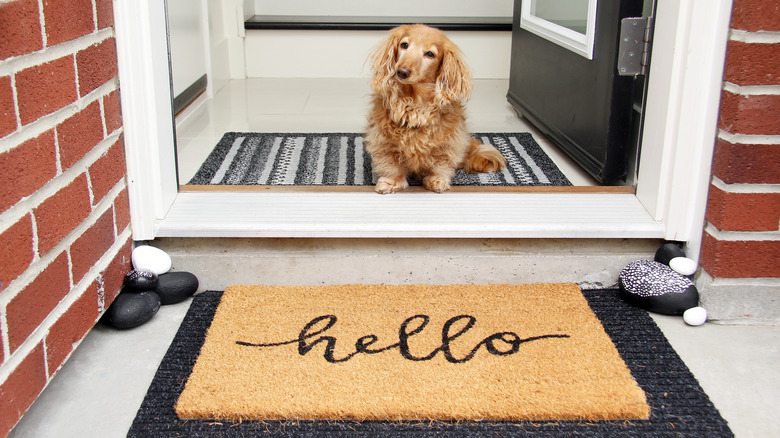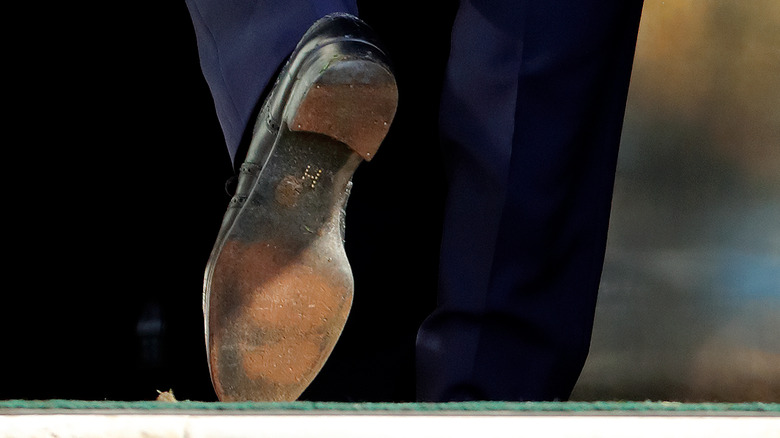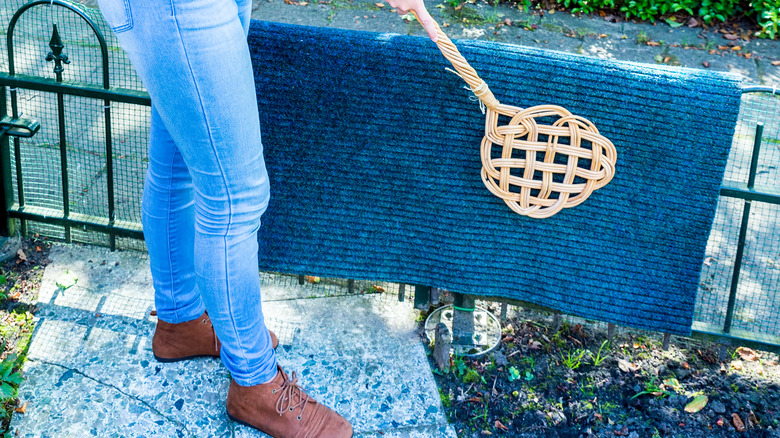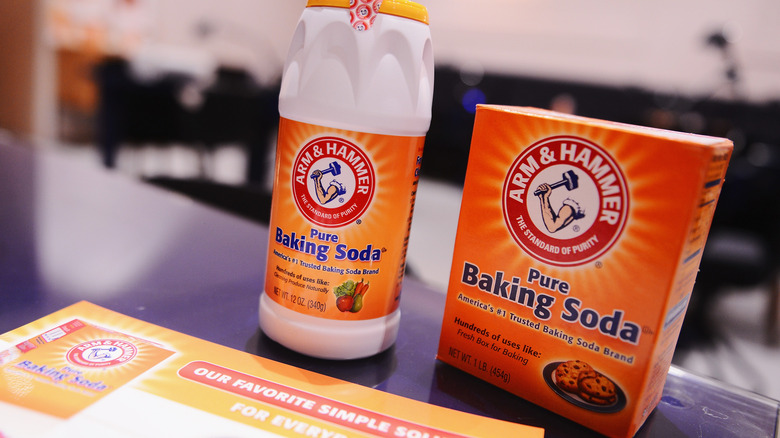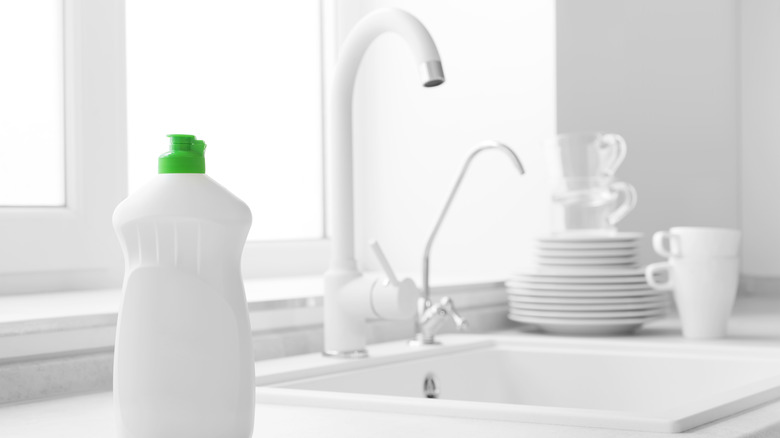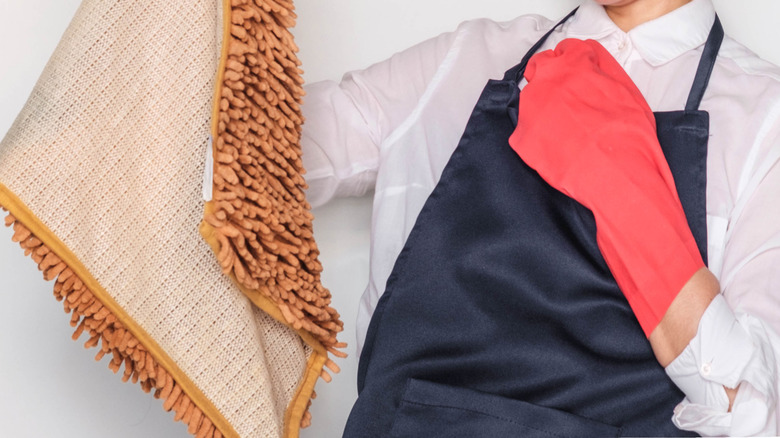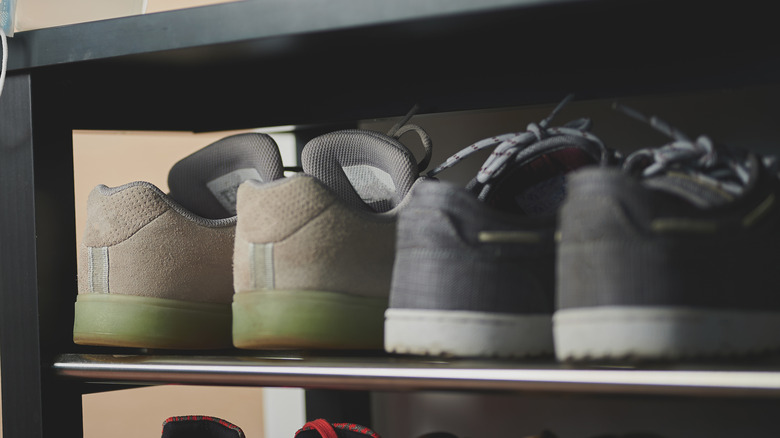How To Best Clean A Doormat
Floor mats have decorated homes for thousands of years, with the first known one appearing 6,000 years ago in Mesopotamia, according to Ultimate Mats. Initially, their use differed from the doormats of today. People mostly had earthen floors, and the mats served as seating and sleeping pads rather than a way of preventing dirt from shoes littering the house. Many of these early mats consisted of straw or grass until the early 1800s, when byproducts from weaving looms were also used. By the 20th century, many new materials found their way into floor coverings, including burlap, rubber, canvas, and jute. Whatever it's made of, doormats are remarkably effective. A 150-person building can accumulate more than a pound of dirt just from the shoes people wear — and the right doormat can reduce this refuse by 85% to 95%. That's a big difference for those who need to clean all that up.
Keeping a doormat clean is easy, but you have to practice regular care, said First Mats. After all, this is what helps ensure that your flooring stays tidy. If your mat is filled with grit and gravel, eventually it will find its way to your floor. For most doormats, a good vacuum or shake can remedy the situation, but some coverings also benefit from a deeper cleaner or even a trip to the washing machine. Here's the best way to keep your mats pristine.
Consider the mat's material first
Not all material can be addressed the same way. You should ascertain the best way to rid your doormat of its dust and muck before using any products. The first step is to look at the label — what is your mat made from? Most modern-day doormats contain a synthetic pile on a rubber or vinyl base. Many of these can go into the washing machine or sparkle up well with detergent or carpet cleaner and some water. Even if the label says these ingredients are permissible, always try the product on a small section before saturating the whole thing.
Think about the size of your mat as well; some will not fit into your washing machine. Coir matting is another popular mat type made from coconut shell husks. This material gives you durable but absorbent matting — so detergents can soil it. Instead, you'll want to use a dry cleaning product such as baking soda (per First Mats).
Vacuum or beat out the dirt
All doormats, whatever materials they contain, benefit from a brisk cleaning on a weekly basis using a bit of muscle and your vacuum cleaner. This two-fold process will remove debris and allergens and keep the area around your door tidy. Start by shaking the floor covering outside — this should take away much of the dirt. Some people like to beat it on the sidewalk or other outdoor surface or even hang it from a clothesline and use a carpet beater to remove the dust and other build-up. As you repeatedly hit the doormat, you'll dislodge any muck it has.
Afterward, you can use a vacuum cleaner to get anything that remains, either your regular machine or a smaller hand-held version. You might want to repeat this more, depending on the environment around your home. For example, during snowstorms removing the salt daily from your doormat will prevent people from tracking it indoors (from The Spruce).
Use baking soda to deodorize
Anytime you do a general doormat cleaning, you can add on some extra techniques to spruce it up even more. For instance, baking soda, often used in DIY solutions, works well on your doormat, too.
After you finish your vacuuming and the bulk of the dust and dirt is dissipated, try sprinkling some baking soda on the mat to keep it sweet-smelling, said How to Clean Stuff. You can either use a scrub brush or a broom to sweep the substance into the fibers, then allow it to penetrate them for several minutes. If your mat won't become damaged by water, you can rinse everything off with a hose; the pressure will also help remove any build-up. Make sure that you prop the doormat up as it dries so both sides can become free of the H20. For more delicate mats, you can also simply vacuum up the baking soda, said The Spruce.
How to clean doormat stains
Sometimes the vacuum, broom, and baking soda won't take out the stubborn stains, and you might need some stronger stuff. In cases like these, a mixture of dish soap and water can help, said SFGate. First, scrub the area with the solution and a brush, then leave it for five to 10 minutes to soak. Next, rinse until all bubbles are gone and hang the mat on a clothesline or over your porch's railing or a deck chair — in the sun, if possible. This will help it dry. If you leave it flat and pockets stay wet, all your good work might be for nothing if mildew forms.
WD-40 also recommends creating a solution using a mild detergent and water. You can put this on the stains and work it into them with a toothbrush. Allow this to penetrate the area for an hour, and then take water and paper towels to blot up the cleanser. You can repeat this process until the mat is like new again.
Use antimicrobial spray on doormats
Besides cleaning your doormat regularly, you can keep all those nasty bacteria, germs, or viruses at bay by using an antimicrobial spray in between all your doormat housekeeping endeavors. Such a spray won't prevent everything, of course, as Sweeping Dimensions Cleaning Service said, but it will keep your floor mat smelling clean and allow its surface to stay sanitized.
You can use a DIY version or something more commercial, such as an off-the-shelf product like Lysol. Don't forget to wear reusable or plastic gloves when spraying; you want it on your mat NOT irritating your hands, said Martha Stewart. You should also evaluate your doormat as you perk it up, added Sweeping Dimensions Cleaning Service. These handy mats are tough, but they don't last forever. If you see it crumbling or coming apart, it's time to buy a new one. Sometimes the best way to keep your floors clean is to remove and replace the doormat.
Consider going shoe-free inside
Sometimes cleaning is about prevention. If you reconsider where you leave your shoes — say, on the front porch before you come in — you will make your doormat's work so much easier. "A shoe-free home is a clean home!" said Jenna Arkin, vice president of innovation at ECOS, to Martha Stewart. "Leaving shoes just inside the door after using the doormat ensures that you're not tracking extra dirt and soil inside the home." Keeping shoes off not only makes those doormats cleaner, but it prevents all that dirt, oil, and bacteria from ever entering your home, said Healthline. Plus, less vacuuming and cleaning prevent some wear and tear for your carpets and floors.
To go shoeless, you can create a shoe area on your porch, mudroom, or by the front door. You can leave a shoe rack there and even put out slippers for those who dislike going barefoot. For visitors, you can simply ask if they mind leaving their shoes (and their dirt) at the door.
